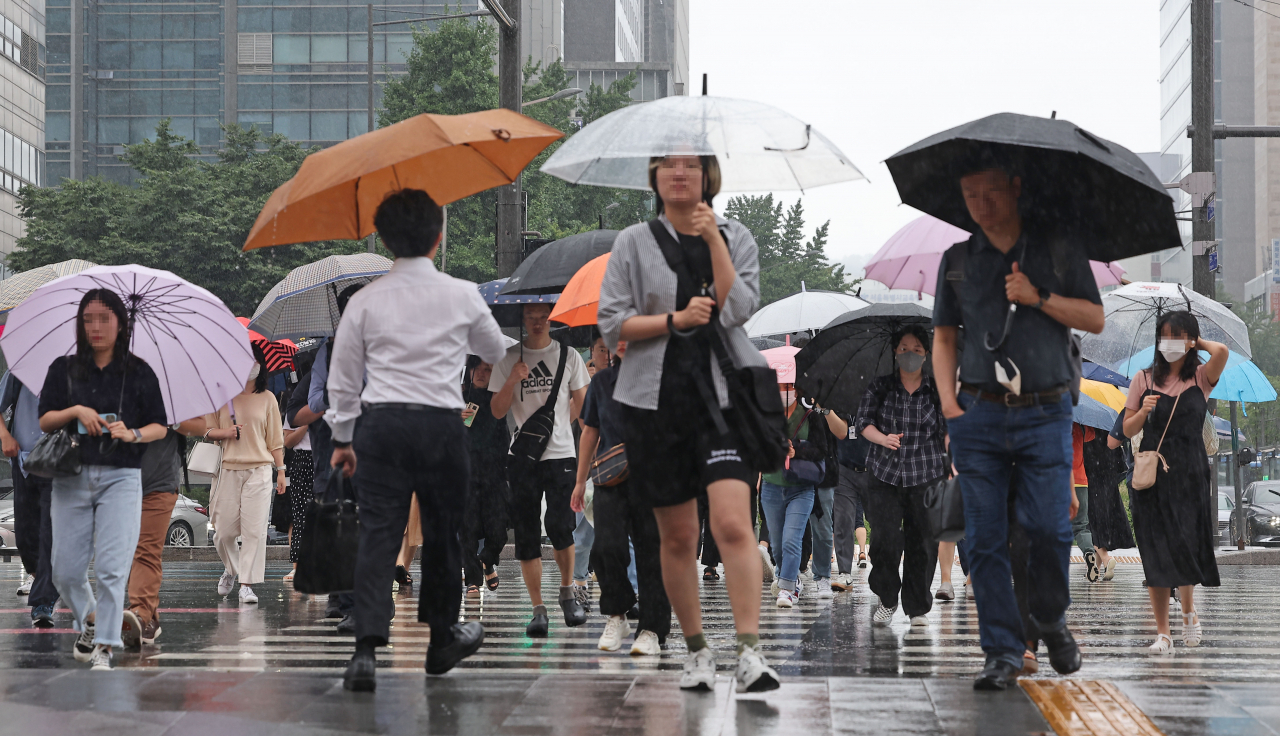Summer 2023 was hotter, wetter than usual
Climate change behind unusually hot summer: weather agency
By Lee Jung-younPublished : Sept. 7, 2023 - 16:20

This year's summer was unusually hot and humid, with the average summer temperature ranking the fourth-highest in South Korea's modern history, while the average quantity of rainfall ranked fifth, according to the national weather agency Thursday.
The average temperature nationwide this summer was 24.7 degrees Celsius, 1 C higher than the average and the fourth-highest average temperature since 1973, when the weather observation network was expanded nationwide and started to compile relevant data.
The average monthly temperature for the three months from June to August was higher than the average temperature of each month. Such a phenomenon has occurred only three times over the past 51 years, including this year. The average temperature in June was 22.3 C, 25.5 C in July and 26.4 C in August. These figures are 0.9 C, 0.9 C and 1.3 C higher than the average temperatures for each month, respectively.
High temperatures at night were also notable, where the lowest overnight temperatures recorded their second-highest average since 1973.
This summer's average maximum temperature was 29.3 C, lower than 2018's 30.4 C, which is considered the hottest year on record, and 0.8 C higher than the average temperature. The number of days with a heat wave -- days with a daily maximum temperature of 33 C or higher -- hit 13.9, higher than the average of 10.7 but lower than the number of heat wave days in 2018, which was 31.
The average minimum temperature this summer was 21.1 C, breaking the records for both an average year and for 2018. The record for an average year is 19.9 C, while the average lowest temperature of the summer of 2018 was 21 C. This year also recorded the second-highest lowest summer temperature next to 2013.
The Korea Meteorological Administration explained that the reason for this year's unusually hot summer was due to the influence of hot winds. From late June to early July, hot and humid air flowed in along the edge of the North Pacific High. The strong southerly winds during the monsoon season maintained high nighttime temperatures despite the rain. Then in early August, the Korean Peninsula experienced high temperatures due to Typhoon Khanun's influence.
In 2018, the heat was caused by strong sunlight as the influence of the Tibetan High and the North Pacific High led to several consecutive clear days and a relatively dry summer.
Korea's nationwide average precipitation this summer was 1,018.5 millimeters, up 291.2 mm from the historical average of 727.3 mm, and ranked fifth in history since 1973. Despite the large amount of precipitation, the average number of rainy days was 40.6, only 2.1 days more than the average. This suggests that there were many instances of intense rainfall over a short period of time.
The average number of days this summer with more than 80 mm of precipitation was 2.8, higher than the 1.8 seen in average years. Days with more than 30 mm of precipitation in an hour hit 2.4 days on average, higher than the 1.6 days in average years. Both records ranked third in history.
Average nationwide precipitation during the monsoon season was 660.2 mm, the third-highest average since records began. In particular, the southern region recorded average monsoon precipitation of 712.3 mm, another record high.
Typhoon Khanun, which passed through the Korean Peninsula on a northward trajectory in early August, also caused heavy rain. On Aug. 10, when Khanun hit the peninsula, 368.7 mm of rain fell in a single day in Sokcho, Gangwon Province, the highest level of precipitation ever recorded in Sokcho.
"This summer, we felt the impact of climate change, with record-breaking rainfall during the monsoon season and an unusual typhoon crossing the Korean Peninsula from south to north. We will enhance monitoring and climate analysis technology amid the climate crisis," said Yoo Hee-dong, chief of the KMA.
Meanwhile, higher-than-usual temperatures are set to continue for a while, despite the onset of the fall season, the KMA said during a briefing Thursday. From Thursday to Sunday, there will be a large difference between daytime temperatures and those of the early morning hours and at night. From Sept. 11, hot and humid air from the south will also cause the temperature to rise.
-
Articles by Lee Jung-youn






![[Weekender] How DDP emerged as an icon of Seoul](http://res.heraldm.com/phpwas/restmb_idxmake.php?idx=644&simg=/content/image/2024/04/25/20240425050915_0.jpg&u=)



![[KH Explains] No more 'Michael' at Kakao Games](http://res.heraldm.com/phpwas/restmb_idxmake.php?idx=644&simg=/content/image/2024/04/28/20240428050183_0.jpg&u=20240428180321)







![[Herald Interview] Mistakes turn into blessings in street performance, director says](http://res.heraldm.com/phpwas/restmb_idxmake.php?idx=652&simg=/content/image/2024/04/28/20240428050150_0.jpg&u=20240428174656)
